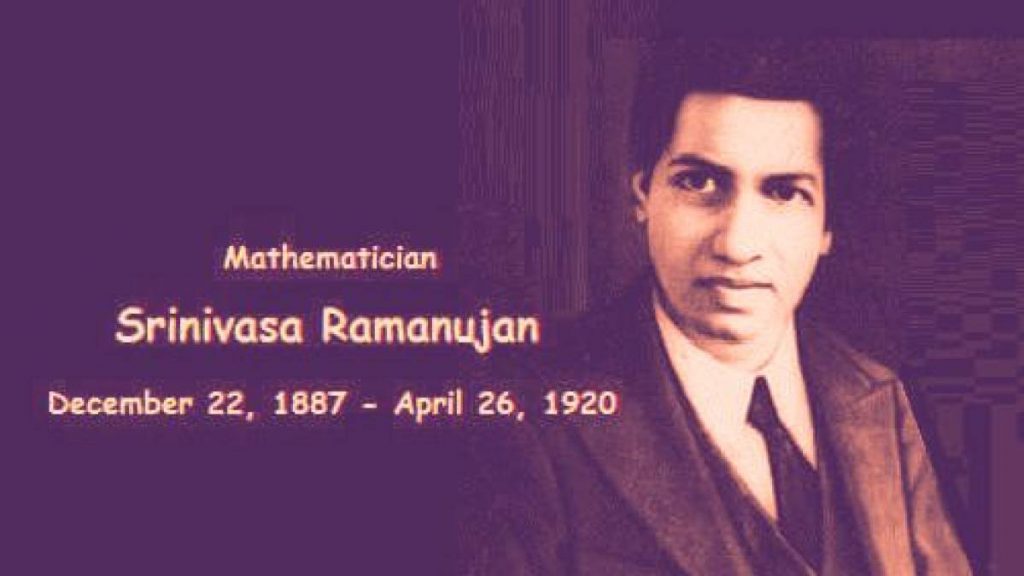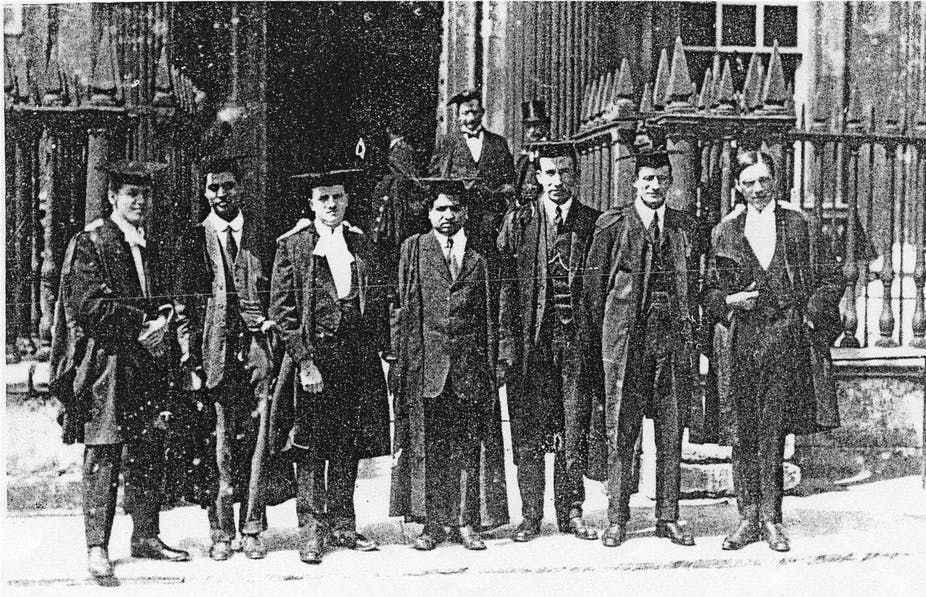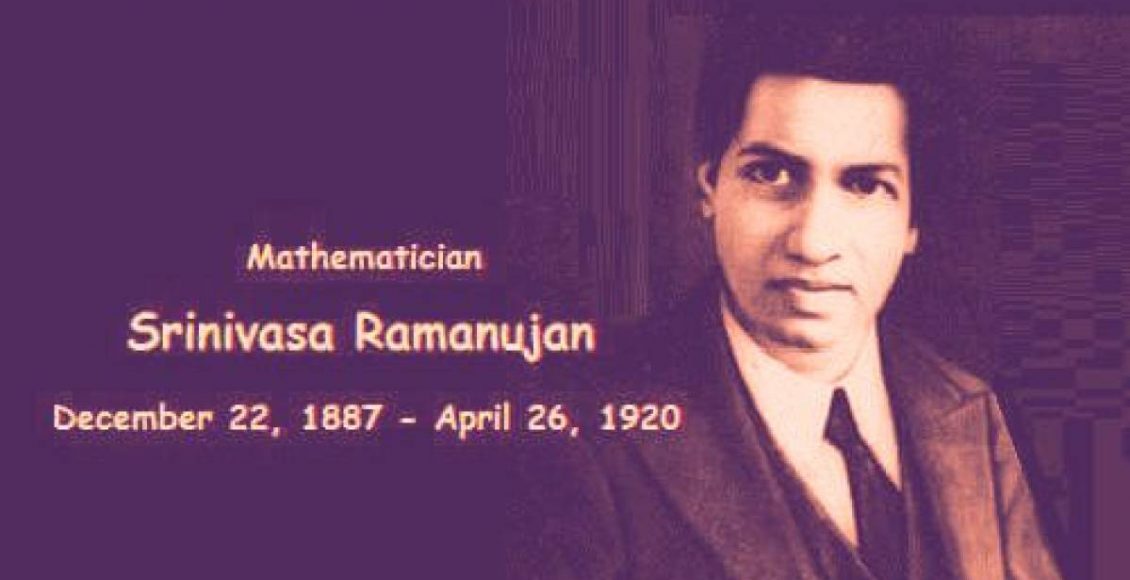Srinivasa Ramanujan Aiyangar – The Mathematical Genius
Dr B P Padhy, Dr Bijan K Patel and Dr Arun K Gupta, School of Applied Sciences (Mathematics)

Srinivasa Ramanujan Aiyangar
The greatest mathematician that India has ever produced and one of the greatest among the world mathematicians, Srinivasa Ramanujan Aiyangar will be remembered for ever as the man who knew infinity. Born in Erode, India on December 22, 1887, Ramanujan lived only for 32 years and died on April 26, 1920. His creative ability and ingenuity have amazed the whole world. In his honour, the DST-ICTP-IMU Ramanujan Prize is given every year in the month of his birth jointly by the International Centre for Theoretical Physics, Italy, Department of Science and Technology, India and International Mathematical Union, Germany. India also celebrates Mathematics Day on December 22, birthday of Ramanujan.
Life of Srinivasa Ramanujan Aiyangar
On December 22, 1887, Ramanujan was born into a Tamil Brahmin Iyengar family in the little-known village of Erode, southwest of Chennai. Ramanujan concentrated on summing mathematical geometry and arithmetic series after failing exams due to his neglect for non-mathematical areas.
When Ramanujan started working as a clerk in the Madras Port Trust in 1912, a co-worker noticed his aptitude for mathematics. His work was published in the Indian Mathematical Society Journal, where he demonstrated the relationships between elliptic modular equations.
He delivered samples of his theorems to three academicians at the University of Cambridge in 1912 and 1913. Recognizing Ramanujan’s talent, G. H. Hardy encouraged him to visit and work with him at Cambridge. The period of six years that he spent with Hardy brought him to the forefront of the world of mathematicians. For his work on extremely composite numbers, he was elected a Fellow of the Royal Society and a Fellow of Trinity College, Cambridge, where he received a B.Sc. (later called Ph.D.).

Srinivasa Ramanujan (middle) with fellow scientists at Cambridge. Source: Wikimedia
He suffered from health troubles in 1916, when he was at his peak working with his collaborator Hardy Littlewood. In Cambridge, he was admitted to the hospital and diagnosed with tuberculosis and acute vitamin insufficiency. In 1919, after a two-year fight, he showed signs of recovery and chose to return to India. Despite all the sensitive care he received from his wife, who nursed him throughout this time, and the greatest medical care from the doctors, Ramanujan died untimely on April 26, 1920, at the age of 32, in Chetput, Madras.
Even during those months of chronic illness, he continued to work at a rapid rate, penning down his findings on sheets of paper, even though he was in a reclined position. He made outstanding contributions to mathematical analysis, number theory, infinite series, and continued fractions despite having no academic instruction in pure mathematics. Ramanujan worked on his own mathematical research for a long time. As a result, in addition to doing new work, he occasionally rediscovered established theorems.
Ramanujan’s contributions to the theory of numbers include pioneering discoveries of the properties of the partition function. In his short life he gave around 3900 results, mostly equations and identities, and almost all of them prove to be correct and original. In recognition of Ramanujan’s achievements,
Ramanujan had his work published in the Journal of the Indian Mathematical Society. One of the first problems he posed in the journal was to find the value of

He formulated an equation that could be used to solve the infinitely nested radicals problem

Using this equation, the answer to the question posed in the Journal was simply 3, verifiable by setting x = 2, n = 1, and a = 0.
Ramanujan wrote his first formal journal paper on the properties of Bernoulli numbers. One property he discovered was that the denominators of the fractions of Bernoulli numbers are always divisible by six. He also devised a method of calculating Bn based on previous Bernoulli numbers. In his paper “Some Properties of Bernoulli’s Numbers” (1911), Ramanujan gave three proofs, two corollaries and three conjectures.
Hardy recognised some of Ramanujan’s formulae but others “seemed scarcely possible to believe”. One of the theorems Hardy found amazing was (valid for 0 < a < b + 1/2):

Hardy was also impressed by some of Ramanujan’s other work relating to infinite series:
The first result had already been determined by G. Bauer in 1859. The second was new to Hardy, and was derived from a class of functions called hypergeometric series, which had first been researched by Euler and Gauss.
Ramanujan was awarded a Bachelor of Arts by Research degree (the predecessor of the Ph D degree) in March 1916 for his work on highly composite numbers.
Ramanujan made many advances, especially in the partition of numbers (the number of ways that a positive integer can be expressed as the sum of positive integers; for example, 4 can be expressed as 4, 3 + 1, 2 + 2, 2 + 1 + 1, and 1 + 1 + 1 + 1). His papers were published in English and European journals, and on 6 December 1917, he was elected to the London Mathematical Society. On 2 May 1918, he was elected a Fellow of the Royal Society, the second Indian to be admitted after Ardaseer Cursetjee in 1841, for his investigation in “elliptic functions and the theory of numbers.” At age 31, Ramanujan was one of the youngest Fellows in the Royal Society’s history. On 13 October 1918, he was the first Indian to be elected a Fellow of Trinity College, Cambridge.
In mathematics, a Ramanujan–Sato series generalizes Ramanujan’s pi formulas such as,

to the form

by using other well-defined sequences of integers s(k) obeying a certain recurrence relation, sequences which may be expressed in terms of binomial coefficients C(n,k) and A, B, C employing modular forms of higher levels.
In 1918, Hardy and Ramanujan studied the partition function P(n) extensively. They gave a non-convergent asymptotic series that permits exact computation of the number of partitions of an integer. In 1937, Hans Rademacher refined their formula to find an exact convergent series solution to this problem. Ramanujan and Hardy’s work in this area gave rise to a powerful new method for finding asymptotic formulae called the circle method.
Ramanujan discovered mock theta functions. For many years these functions were a mystery, but they are now known to be the holomorphic parts of harmonic weak Maass forms.
The number 1729 is known as the Hardy–Ramanujan number after a famous visit by Hardy to Ramanujan at a hospital. In Hardy’s words, “I remember once going to see him when he was ill at Putney. I had ridden in taxi cab number 1729 and remarked that the number seemed to me rather a dull one, and that I hoped it was not an unfavorable omen.” “No”, he replied, “it is a very interesting number; it is the smallest number expressible as the sum of two cubes in two different ways.” The two different ways are:

Generalisations of this idea have created the notion of “taxicab numbers“.
The Landau–Ramanujan constant is the positive real number b that occurs in a theorem proved by Edmund Landau in 1908, stating that for large x, the number of positive integers below {\displaystyle x}x that are the sum of two square numbers behaves asymptotically as
This constant b was rediscovered in 1913 by Srinivasa Ramanujan, and is mentioned in the first letter he wrote to G. H. Hardy.
In mathematics, the Ramanujan–Soldner constant (also called the Soldner constant) is a mathematical constant defined as the unique positive zero of the logarithmic integral function. It is named after Srinivasa Ramanujan and Johann Georg von Soldner.
In q-analog theory, the Ramanujan theta function generalizes the form of the Jacobi theta functions, while capturing their general properties. In particular, the Jacobi triple product takes on a particularly elegant form when written in terms of the Ramanujan theta. The function is named after Srinivasa Ramanujan.
In number theory, a branch of mathematics, Ramanujan’s sum, usually denoted cq(n), is a function of two positive integer variables q and n defined by the formula:

where (a, q) = 1 means that a only takes on values coprime to q.
Srinivasa Ramanujan mentioned the sums in a 1918 paper. In addition to the expansions discussed in this article, Ramanujan’s sums are used in the proof of Vinogradov’s theorem that every sufficiently-large odd number is the sum of three primes.
In mathematics, the Rogers–Ramanujan identities are two identities related to basic hypergeometric series and integer partitions. The identities were first discovered and proved by Leonard James Rogers (1894) and were subsequently rediscovered (without a proof) by Srinivasa Ramanujan some time before 1913.
In mathematics, Ramanujan’s master theorem (named after Srinivasa Ramanujan) is a technique that provides an analytic expression for the Mellin transform of an analytic function.
Ramanujan had noted down the results of his research, without proofs (as in A Synopsis of Elementary Results, a book on pure Mathematics, by G.S. Carr), in three notebooks, between the years 1903–1914, before he left for England. These were the notebooks which he showed to his benefactors to convince them about his abilities as a mathematician. The first notebook had 16 chapters in 134 pages. The second was a revised, enlarged version of the first, containing 21 chapters in 252 pages. And the third notebook contained 33 pages of unorganized material.
In his paper “On certain arithmetical functions”, Ramanujan defined the so-called delta-function, whose coefficients are called τ(n) (the Ramanujan tau function). He proved many congruences for these numbers, such as τ(p) ≡ 1 + p11 mod 691 for primes p. This congruence (and others like it that Ramanujan proved) inspired Jean-Pierre Serre (1954 Fields Medalist) to conjecture that there is a theory of Galois representations that “explains” these congruences and more generally all modular forms. Δ(z) is the first example of a modular form to be studied in this way. Deligne (in his Fields Medal-winning work) proved the Serre’s conjecture. The proof of Fermat’s Last Theorem proceeds by first reinterpreting elliptic curves and modular forms in terms of these Galois representations. Without this theory there would be no proof of Fermat’s Last Theorem.
It is amazing that in such a short life span, Ramanujan, who had almost no formal education in mathematics up to about six years before his death, gave results of some of the most puzzling problems of mathematics and proved to the world his ability as a master mathematician in a span of six years of his association with the world mathematicians, and made significant contributions to mathematics that are still relevant today. India salutes this all-time mathematical genius.
Bibliography
Berndt, B. C. (12 December 1997), Ramanujan’s Notebooks. Part 5, Springer Science & Business, p. 4. ISBN 978-0-38794941-3.
Berndt, B. C. and R. R. Alexander (2001), Ramanujan: Essays and Surveys, American Mathematical Society, p. 47. ISBN 978-0-82182624-9. Retrieved 8 June 2015.
Embleton, E. (2 October 2018), Revisiting Ramanujan, The Royal Society. Retrieved 16 February 2020.
Hans, E. (1995), Genius, p. 197, Cambridge University Press, ISBN 0-521-48508-8.
Hardy, G. H. (1940), Ramanujan: Twelve Lectures on Subjects Suggested by His Life and Work, Cambridge University Press, p. 9. ISBN 0-8218-2023-0.
Hardy, G. H. (1940), Ramanujan. Cambridge: Cambridge University Press, p. 10.
Hardy, G. H. (1979), Collected Papers of G. H. Hardy, 7. Oxford, England: Clarendon Press. 720.
Jean-Louis N. and G. Robin, Eds. (1997), Highly Composite Numbers by Srinivasa Ramanujan, The Ramanujan Journal 1, 119–153, p.121.
Kanigel, R., Ramanujan, Srinivasa, Oxford Dictionary of National Biography (online ed.), Oxford University Press. doi:10.1093/ref:odnb/51582.
Krishnamurthy, V. Srinivasa Ramanujan – His Life and His Genius. www.krishnamurthys.com.
Ramanujan, S. (1968), P. K. Srinivasan (Ed.), Ramanujan Memorial Number: Letters and Reminiscences, 1, Madras: Muthialpet High School. 100.
Ranganathan, S. R. (1967), Ramanujan: The Man and the Mathematician, Bombay: Asia Publishing House, p. 23. ISBN 9788185273372.
Rao, C. R. (1997), Statistics and Truth: Putting Chance to Work, World Scientific, p. 185. ISBN 978-981-02-3111-8. Retrieved 7 June 2010.
Seshu Iyer, P. V. (1920), The Late Mr. S. Ramanujan, B.A., F.R.S, Journal of the Indian Mathematical Society, 12 (3): 83.
The Hindu (2011). Ramanujan Lost and Found: A 1905 Letter from The Hindu, The Hindu. Chennai, India, 25 December 2011.


